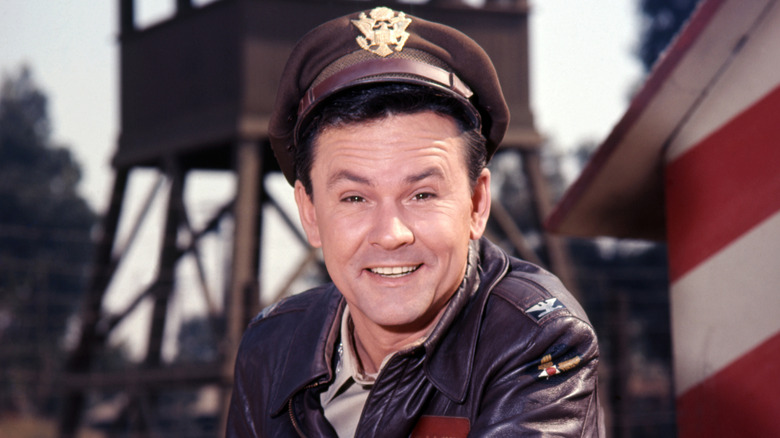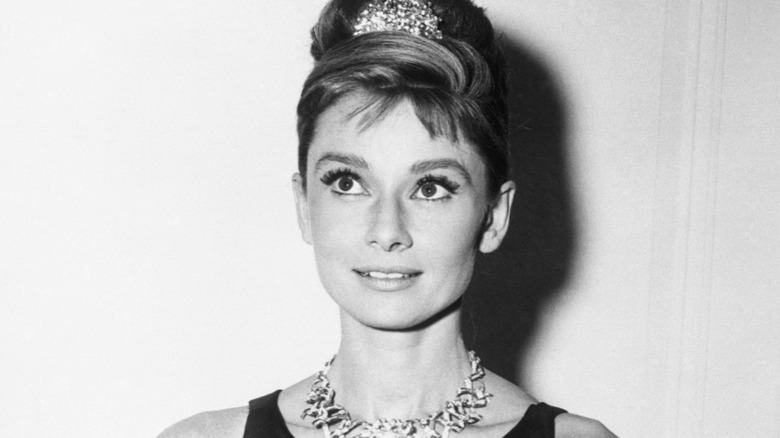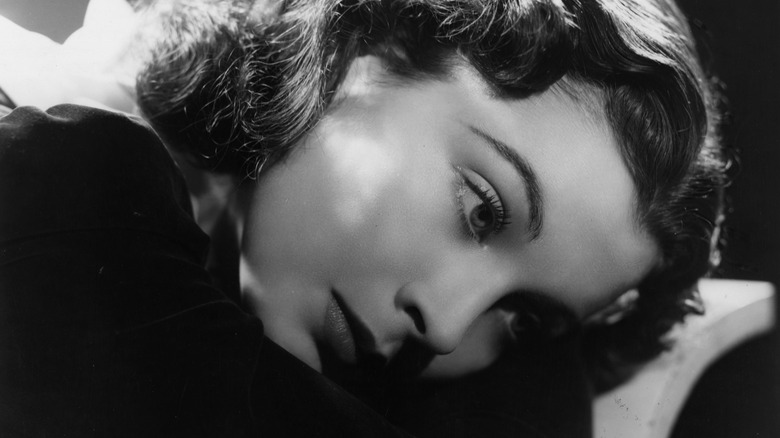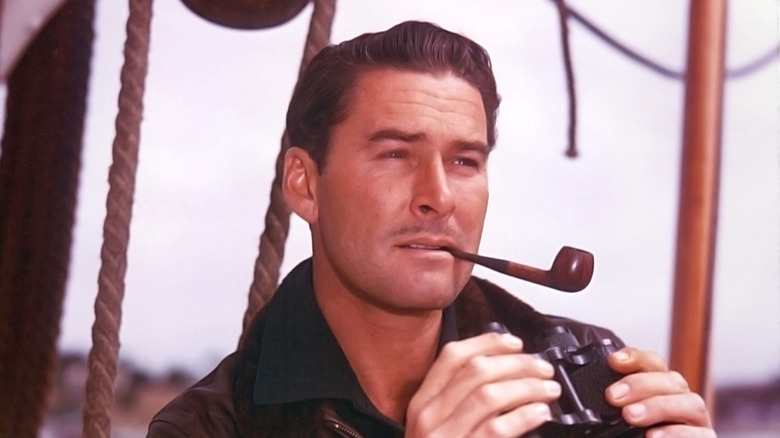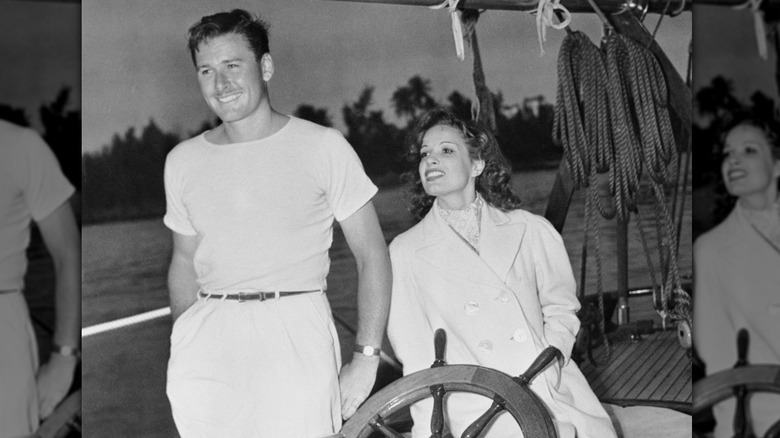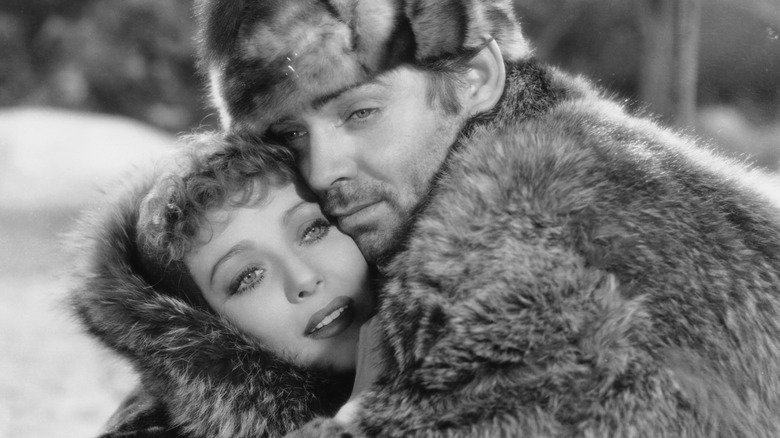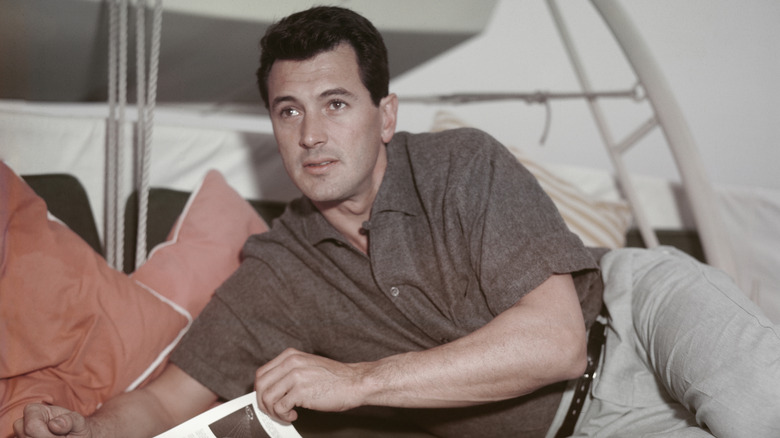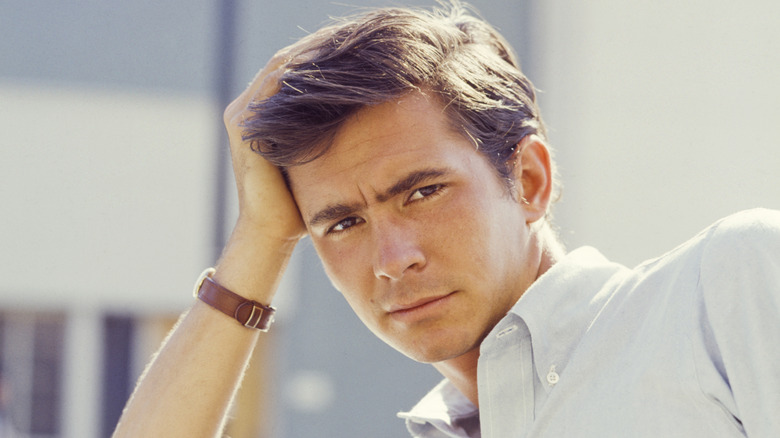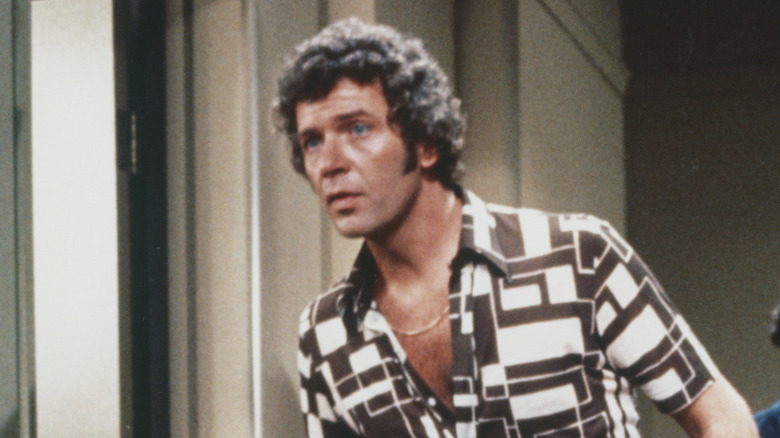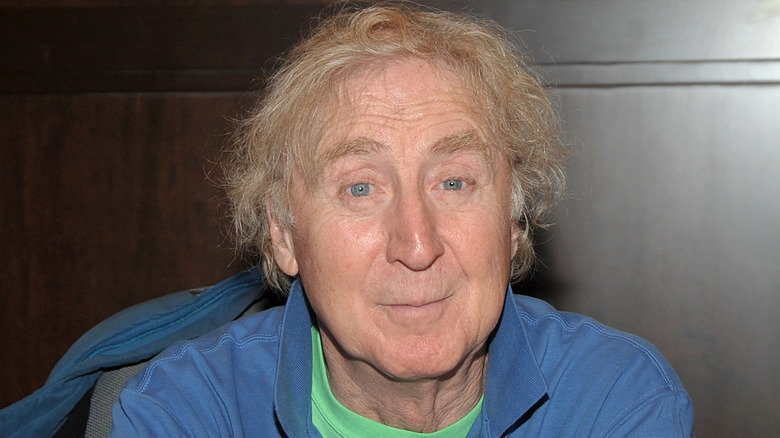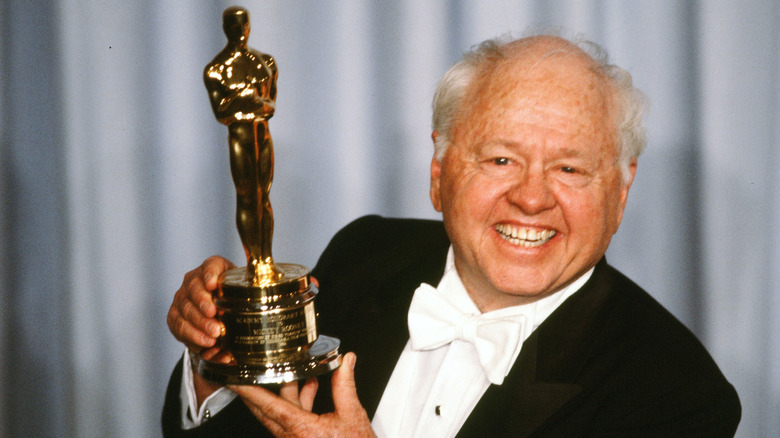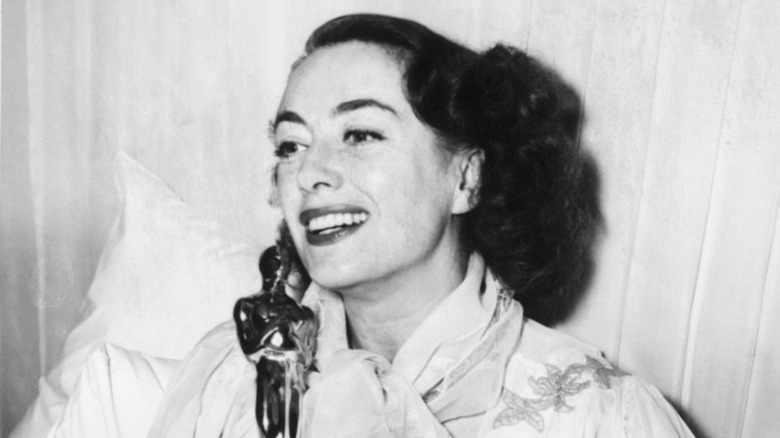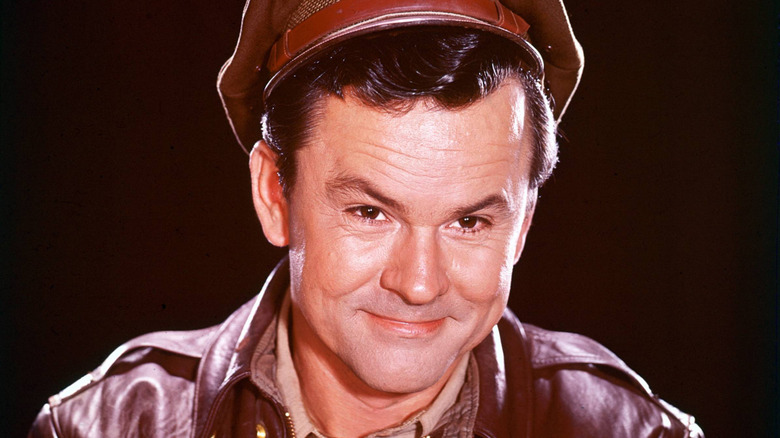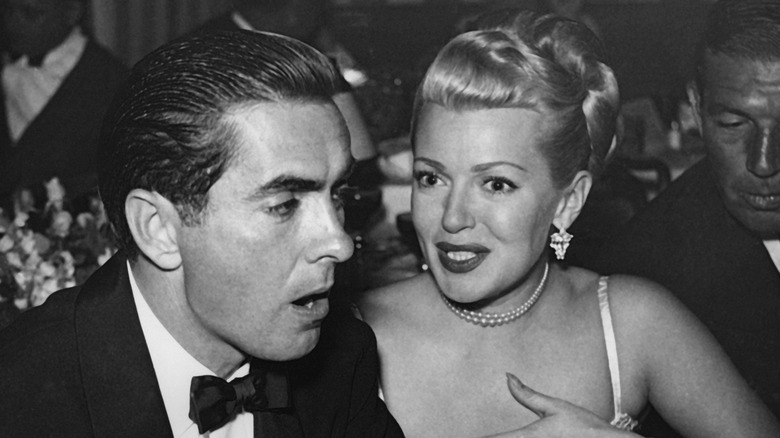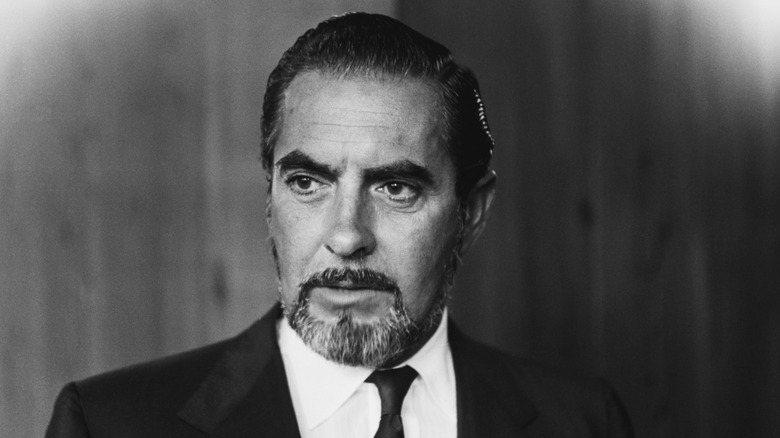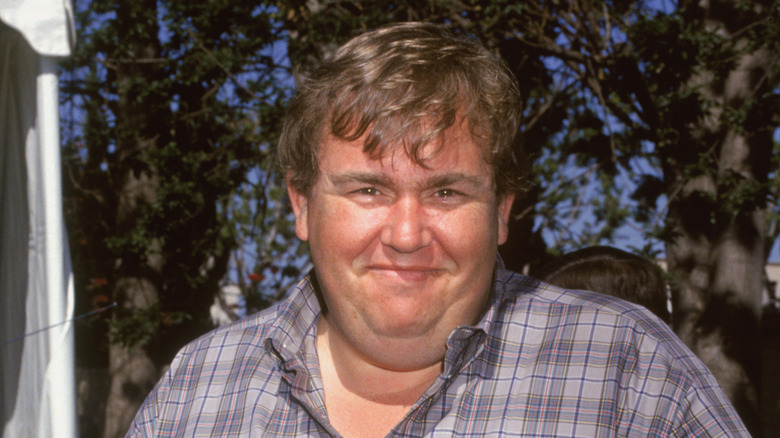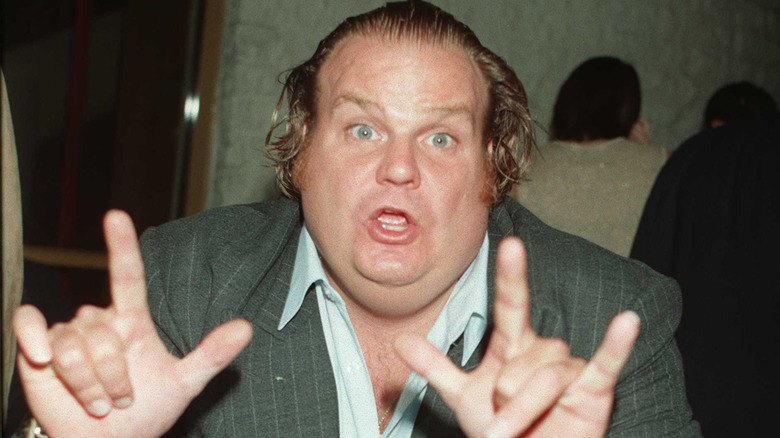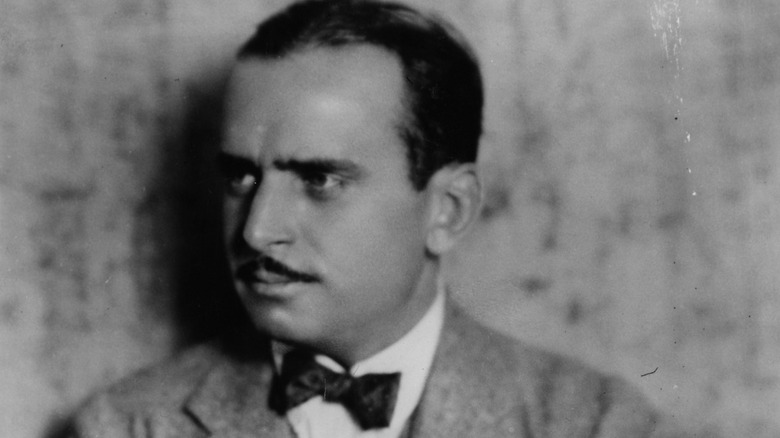Things That Came Out About Hollywood Legends After They Died
We may receive a commission on purchases made from links.
The movie star concept hasn't entirely lost its luster, even in an age of streaming, viral videos, and social media influencers. But there's no denying that star power was far greater in the Golden Age of Hollywood. The ubiquitous place movies held in popular culture for most of the 20th century, combined with the studio system of Hollywood's early and middle years, helped propel scores of actors into national or even international notoriety.
That kind of fame didn't come entirely through acting talent and good movies. The studio system came with contracts, assigned roles, extensive makeovers, and a strict set of rules that Hollywood stars were expected to follow. That kind of careful massaging of an actor's public persona resulted in highly recognizable and appealing images. From Humphrey Bogart to Greta Garbo, Old Hollywood stars were — at least on screen — easily identifiable and familiar to the moviegoing public. Audiences who regularly attended the movies could feel as if they knew the stars who dominated the screen.
But of course, manicured personas are not reality, no matter how much studio publicity claimed otherwise. Actors and actresses had lives away from the cameras, sometimes quite different from the types of roles they embodied on film. And some major details of those lives only emerged after the stars themselves were long gone. They might be scandalous and appalling, or they might be heartwarming or even heartbreaking: here are just a few details about Hollywood legends that only made headlines after their deaths.
The following article includes allegations of child abuse and sexual assault.
Audrey Hepburn was part of the Dutch Resistance
Few classic stars have remained as well-known and celebrated in the modern era as Audrey Hepburn. Fashion photos of her, along with publicity stills from "Breakfast at Tiffany's," may well be more familiar to younger audiences than her film performances, to say nothing of her work with UNICEF. Even fewer probably know about her history with World War II.
Even in her lifetime, Hepburn's service to the Allied cause was something that many never knew about her, and even those who did doubted that Hepburn, who was only a teenager during wartime, could have meaningfully participated. But Hepburn was already a celebrity ballerina in her native Holland, and she participated in underground performances that helped raise money for the Dutch Resistance, as well as for sheltered Jews and others wanted by the Nazis.
Hepburn spoke about these performances, but her fluency in English and unassuming appearance at 15 years old also recommended her for more serious work: running food and messages to downed Allied pilots that the Resistance was working to ferret out of the country. Children throughout Holland were used for such purposes due to the lack of suspicion placed on them, and Hepburn proved her bravery when she used her youth to disarm any Nazi police she encountered while running messages. Her family eventually took to hiding themselves in their cellar in 1945, but they were liberated after three weeks by Canadian troops who were charmed by Hepburn's English.
Vivien Leigh had serious physical and mental health issues
Vivien Leigh had a long and fruitful career, but her most famous performance remains that of Scarlett O'Hara in "Gone with the Wind." The passionate, hot-tempered, and mercurial Scarlett reflected certain aspects of her portrayer. During filming, Leigh could be similarly spirited; "manic" was used to describe her behavior. Similar incidents on other sets led to Leigh being branded difficult to work with.
But Leigh's "difficult" behavior didn't come from the affectations of a movie star. She spent a good portion of her life in poor health. She suffered from recurring bouts of tuberculosis for years and was recovering from such an episode when she died in 1967. But Leigh also likely spent her life with an undiagnosed and untreated case of bipolar disorder.
Those who knew Leigh recalled her exhibiting unusual behavior since childhood, but there was little understanding of bipolar disorder as such during Leigh's heyday, and thus, no reliable options existed to treat it. What options there were, such as shock therapy and sedatives, were ineffective and carried their own dangers. Leigh herself was greatly unnerved by her episodes, which troubled her marriage to Laurence Olivier and continued to cause problems for her career. Her initial shoot days on "A Streetcar Named Desire" were particularly stormy (the experience improved later on). Leigh and Olivier later divorced under the combined pressure of her health issues and their career demands, and she continued to face challenges with her mental health until her death.
Errol Flynn was too sick to serve in World War II
If you're a fan of both classic movies and "The Rocketeer," you've probably recognized the king of the swashbucklers himself, Errol Flynn, in the latter movie's suave, Nazi-affiliated Hollywood villain. Claims after his death that Flynn was a Nazi spy have plagued his reputation for decades, since he maintained a friendship with Dr. Hermann Erben, who was undoubtedly a spy for the Nazis during World War II. But the actor, while not devoid of prejudice himself, was outspokenly anti-fascist. When America entered the war, Flynn tried to enlist with the U.S. Army and the OSS, angling with the latter for an intelligence assignment in Ireland.
The OSS ignored him, the army rejected him, and that was the case for every branch of the U.S. military. Quite simply, Flynn was too sick to serve. Even as a young man, his years of reckless promiscuity had gotten him several STIs. On top of that, he had a weak heart and recurring bouts of malaria. These conditions were already a hindrance to his career; Flynn often collapsed on set. Denied any role in the military, the closest he could come to service was starring in war-themed films.
The fact that Flynn never went to war left critics and even friends suspicious of his convictions, even if they didn't believe he was a Nazi spy, but Flynn's extenuating circumstances were never made public. His home studio, Warner Bros., didn't want it known that a star they marketed for his athletic, swashbuckling bravado on-screen was in such poor health.
Errol Flynn had a sordid sexual life
That Errol Flynn was a womanizer was well-known in his lifetime. The war years saw him not just criticized for his failure to serve, but on trial for two counts of statutory rape. The teenage girls in question gave vivid testimony about the incidents, but Flynn's lawyers were ruthless in their questioning, and legions of fans flocked to support their star. The majority-woman jury acquitted Flynn on all counts.
Fans were delighted that Flynn was found innocent, but there was much about his sexual life that suggests, at best, disreputable conduct. Flynn's Hollywood home was the site of many wild parties, as well as covert ways for the host to enjoy anything he wanted to see. Hedy Lamarr, Robert Douglas, Ron Wood, and others who visited the house were quoted in Robert Matzen's "Errol Flynn Slept Here" that the house was full of two-way mirrors, peepholes, and recording devices that let Flynn indulge his voyeurism whenever guests headed to the bedroom or the women's bathroom.
Flynn found himself mixed up with underage girls again toward the end of his life. After Flynn's tragic death from a lifetime of excessive drinking, Florence Aadland published "The Big Love," a book claiming that Aadland's 15-year-old daughter became sexually involved with Flynn. The daughter, Beverly, later confirmed the story, adding that Flynn had "virtually" raped her on their first encounter, though she later "fell in love with him" (via The Telegraph).
Loretta Young had a daughter by Clarke Gable
When Loretta Young died in 2000, it wasn't news that she had a child. The Oscar winner had announced her daughter, Judy Lewis, to the press decades earlier. But what almost no one knew until 1994 was that Lewis was not adopted, as Young had maintained. Lewis herself only learned the truth as an adult: that she was the illegitimate child of Young and Clark Gable, conceived while the two carried on an affair on the set of "Call of the Wild."
Rumors about Lewis' parentage floated around Hollywood as she grew up, but she never even suspected such a thing until her mother told her. Lewis herself made her parentage public knowledge through her memoir, "Uncommon Knowledge," and for doing so, Young refused to speak to her for three years. Young, a devout Roman Catholic, told Lewis about her unhappiness over the circumstances of the birth. For her part, Lewis attributed the uncertainty she grew up with about her parentage with throwing off her own relationships as a young woman.
Young would eventually confirm her daughter's account through her memoir, written by Joan Wester Anderson and only published after Young's death. And Lewis revealed another detail about her heritage after her mother died. In 1998, as the two watched "Larry King Live" (per Buzzfeed News), the subject of date rape came up. When Lewis and a houseguest explained it, Young told them: "That's what happened between me and Clarke." Gable himself never acknowledged Lewis and only saw her once, just after she was born.
Rock Hudson was gay
Younger audiences who've heard of Rock Hudson may not think twice about the fact that he was a gay man. After all, Hudson being gay is a part of his legacy, but it was a major revelation to film fans and Americans in 1985 that Hudson, who tragically died from AIDS, was a homosexual.
Hudson, whose real name was Roy Scherer Jr., had good reasons to want to keep his sexuality private during his Hollywood heyday. The homophobia of mid-century America was certainly a factor, but there were other professional concerns. Hudson's stage name and screen persona were carefully crafted to reflect a rugged, all-American he-man archetype. A sham marriage and the denials of friends helped him maintain this image, though his sexuality has been described as an open secret in Hollywood at the time. An agent also helped cover things up by leaking stories about other clients, and Hudson was diligent about how photographs of himself and other details of his personal life were made available to the public.
The news that Hudson was a gay man — and more importantly, a man dying of AIDS — was a watershed moment in the AIDS crisis of the 1980s. Before his diagnosis was made public, there was a great deal of stigma around the disease and its victims, who were often faceless to the average American. Hudson's suffering and death from AIDS have been directly credited with shifting the views of his friend, President Ronald Reagan, who had been inattentive towards the crisis until that time.
Anthony Perkins died of AIDS
Anthony Perkins knew he would die of AIDS. The "Psycho" star was diagnosed in 1990, two years before his death. But he never let the public know until he was almost at the end. A posthumous statement (via POZ) gave his reasons: "I chose not to go public about this, because to misquote 'Casablanca,' I'm not much at being noble, but it doesn't take too much to see that the problems of an old actor don't amount to a hill of beans in this crazy old world."
Perkins had other reasons than modesty and perspective for keeping his illness to himself. His wife, Berry Berenson, told the Times that Perkins was afraid that going public with his diagnosis would mean that he would never work again. He was already in the midst of a dry spell before he became sick, so strong was the stigma of his most famous role. The two of them regularly signed into hospitals under aliases while he held out for the possibility of more work, and only family and a few choice friends were told the truth.
That Perkins had HIV leaked out to the tabloids before he revealed his AIDS diagnosis. He only began telling people in his life at the urging of his wife, who found the strain of keeping up pretenses otherwise too much. Tabloid interest intensified, and Perkins slipped into depression at the very end of his life.
Robert Reed was HIV positive
There was much about Robert Reed that didn't match his character from "The Brady Bunch." Reed was a difficult, problematic presence on the set; he didn't enjoy working on "The Brady Bunch" and made no bones about it. A Shakespearean-trained actor, he considered a sitcom and the medium of television beneath him. He regularly threw notes at the writers and series creator Sherwood Schwartz.
But Florence Henderson, Reed's "Brady Bunch" co-star, offered another explanation for his unhappiness to ABC News. "He was an unhappy person," she said. "I think had Bob not been forced to live this double life, I think it would have dissipated a lot of that anger and frustration." That double life concerned his sexuality; Reed was a gay man. Henderson and his other co-stars had a silent understanding of his sexuality, but he never discussed it with them nor made it public.
Reed continued appearing in iterations of "The Brady Bunch" despite his contempt for the material, and he continued accepting other parts. Work became more difficult for him by 1990, by which time he was suffering from colon cancer. The cancer was initially considered the primary cause of death when he died in 1992, but it was later reported that Reed was HIV positive by the time of his death. While some believe that may have contributed to his death, Reed was not officially diagnosed with AIDS.
Gene Wilder kept his Alzheimer's diagnosis secret
Gene Wilder was fond of telling the story of how his somersault in "Willy Wonka and the Chocolate Factory" came about. He insisted that his hobbling walk with a cane, ending in a bit of athleticism, was essential for his character. "From that time on," he reasoned, "no one will know whether I'm lying or telling the truth" (via Collider).
Wilder's devised entrance resulted in one of many memorable moments for the character of Willy Wonka, and Wilder's portrayal of him remains beloved by audiences of all ages. But "Willy Wonka" is a children's movie first and foremost, and it was children that Wilder had in mind when he made the decision to keep his Alzheimer's diagnosis private. His nephew Jordan Walker-Pearlman told the Associated Press (via Forbes) that Wilder didn't want any young fans to be worried or disappointed by him if they encountered him in a diminished state. "[They] would not have to be then exposed to an adult referencing illness or trouble," Walker-Pearlman said. "He simply couldn't bear the idea of one less smile in the world."
Wilder died from Alzheimer's in 2016 while listening to "Somewhere Over the Rainbow." Only after he passed did Wilder's family reveal the cause of death. The Alzheimer's Association (via The Hollywood Reporter) expressed its appreciation and understanding for the delayed announcement.
Mickey Rooney may have suffered from elder abuse
Mickey Rooney shot to fame as a child star in musicals and comedies from the Golden Age of Hollywood. Generations who grew up with the Rankin/Bass stop-motion Christmas specials know him (or at least his voice) as Santa Claus. Behind the scenes of such joyous entertainment, Rooney's on-set behavior could often turn difficult and problematic, and his personal life was similarly troubled; Rooney was married eight times. And after his death, reports emerged suggesting that his life ended in abuse and estrangement.
The abuse in question was directed at Rooney himself, according to The Hollywood Reporter. The magazine ran an in-depth article the year after Rooney's 2014 death alleging that his wife Jan maintained strict control over Rooney's life and finances, cut him out of the most basic decisions about his life, and physically assaulted him on more than one occasion. Jan's son Chris was accused of embezzling $8.5 million from Rooney's estate. Jan's insistence to the contrary was challenged by several witnesses involved in Rooney's care, and the Reporter claimed that she sometimes admitted to assaults, though not on the record with them.
In retaliation, a few weeks before his death, Rooney wrote a new will disinheriting Jan and all his surviving children, who he claimed were better off financially than he was. He left the bulk of his diminished estate (which may have been as little as $18,000) to his stepson Mark Rooney. But legal battles connected to his abuse lingered on well after Rooney's death.
Joan Crawford and Mommie Dearest
For posthumous revelations about classic Hollywood stars, few have been as well-publicized and notorious as Joan Crawford's alleged treatment of her daughter. "Mommie Dearest" is still an easy reference for writers reaching for a pithy way to describe parental horror stories and the tell-alls penned by their children. That book, written by Crawford's adopted daughter Christina, came out just one year after Crawford's death.
Among the allegations detailed in "Mommie Dearest" were instances of Crawford beating her daughter with a wire hanger, waking her children up in a drunken stupor, and other severe beatings (per The Hollywood Reporter). Crawford's adopted son Christopher, who also had a poor relationship with her, supported all of Christina's accusations.
Crawford wrote about child-rearing herself in two different books, and painted a far more positive image of herself as a mother. Her twin children, Cindy and Cathy, also challenged their stepsiblings' claims. However, there must have been some foundation to the animosity between mother and stepchildren, since in her will, Crawford made a point to disinherit them. "It is my intention to make no provision herein for my son, Christopher, or my daughter, Christina," she wrote (via the Daily Express), "for reasons which are well known to them." They estranged pair went to court to successfully claim some money from the estate, though Christina would later be successfully sued by Cathy for defamation.
Bob Crane kept tapes of his sex life
"Hogan's Heroes" is an anomaly among American sitcoms, one that would be very unlikely to be made today. It was a show featuring plucky American POWs and their bumbling, even likable, Nazi "captors" made when World War II was still a living memory, which went on to be a six-season hit. And leading the cast was Colonel Hogan himself, Bob Crane, a former radio man with an easy charm on camera.
Within show business, it was an open secret that Crane had a darker side away from the "Hogan" sets. Behind a clean-cut façade and a nuclear family, Crane was a voracious sex addict. He carried on innumerable affairs and, though there has never been an insinuation of coercion or deception, he did film his sexual conquests. His house was stashed with pornography, personal photographs, and film strips. Success through "Hogan's Heroes" only let him indulge his habit more, and his habit of showing pieces of his collection to co-stars began hurting his career. But Crane's sexual practices exploded into the public eye after he was murdered in 1978.
His son Robert suspected that the killer was Jonathan Carpenter, a friend who helped Crane with his private video equipment but who Crane, Robert claimed, had grown tired of. Despite extensive circumstantial evidence, Carpenter wasn't charged until 1992 (per Entertainment Weekly), and what was left from a contaminated crime scene wasn't enough to convict him. Robert also suspected his stepmother as another possible killer, but those suspicions were not taken seriously by authorities.
Tyrone Power's relationship with Lana Turner resulted in a pregnancy
Not unlike Errol Flynn, Tyrone Power was presented to the moviegoing public of the 1930s and '40s as a romantic, swashbuckling hero. Power, who was the third generation of his family to go into acting, took the profession far more seriously than Flynn and strove all his life to prove his mettle as a performer. He was also not quite as hedonistic as Flynn.
But Power still lived large in Hollywood, and his marriages were complicated by his string of extramarital affairs. It has been widely claimed since his death that Power was bisexual, and one biographer claimed on an A&E documentary (via YouTube) that Power's affairs with men were a relief from those he had with women, which "gave him a big headache." Even if that was the case, Power willingly entered into numerous affairs with the leading ladies of his day, including Lana Turner.
Theirs was a brief but intense relationship, described in contemporary reporting as an infatuation on Power's part and an obsessive romantic attraction on Turner's. Their differing expectations for the relationship – Turner wanted marriage, whereas Power wanted to reconcile with his wife – were given as the reason why the affair fizzled. But years after Power's death, Turner revealed in her memoir "Lana" that she had gotten pregnant by Power during their time together. Turner wrote that both of them wanted the baby but didn't think their careers could survive the scandal. On the advice of a studio executive's wife, Turner had an abortion.
Tyrone Power refused to learn about what would eventually be the cause of his own death
The legacy of his name was something Tyrone Power held dear to his heart. His great-grandfather and father were both character actors of note named "Tyrone Power," and he longed to follow in their footsteps. Power's early professional work was done under his father's wing on the American stage, and they planned to make it big in Hollywood together before Tyrone Power Sr. died of a massive heart attack after taking ill on another film set.
Years later, in memory of his father, Power filmed a public service announcement advising Americans on the importance of regular check-ups on their heart health. He was in his early 40s at the time and still noted for his good looks and athletic frame. But when Power went in for his yearly physical, the doctor asked for a second cardiogram. Power refused to investigate further. "If there's something wrong," he told the doctor, "I don't want to know" (via YouTube).
With that refusal, Power went to his death not knowing there was anything wrong. But when he collapsed on the set of "Solomon and Sheba" in 1958, the cause of death turned out to be a massive heart attack. In dying on set, Power fulfilled one of two remaining wishes he had for his life: to have a son bearing his name and to die on stage. The son followed shortly after his father's passing, and in dying on set, Power once again echoed his own father.
John Candy was terrified of not being liked
Throughout the 1980s and early 90s, John Candy was a fixture in Hollywood comedies. The Canadian actor spanned the range of the genre, from feel-good, family-friendly comedies like "Cool Runnings" to darker, quirkier projects like "Little Shop of Horrors." Toward the end of his life, Candy was also beginning to take on more serious roles in films like "JFK." Candy also had a reputation for being generous with his fellow performers. So it may be surprising to learn that his reputation with them — indeed with anybody — was one of his greatest fears.
In 2023, while reflecting on "Cool Runnings," director Jon Turteltaub told the Independent that "he was very insecure about his place in the Hollywood ecosystem...I know he had fears about his career and how he was perceived by people. His whole life, John hated not being liked. He was afraid of it on a personal and professional level."
Candy's fear of being disliked manifested in different ways. He was loath to turn away any fan or autograph chaser, lest he come off as the bad guy. He fretted to writers on the films he worked on that he was a "dog boy" in Hollywood, a one-note nonentity that no one liked (via Feel the Rhythm). Assurances to the contrary seemed to fall on deaf ears. "It's a bit clichéd that the funny guy might not be the happy guy," says Turteltaub, "but there's a little truth to that. "John was a fun, happy person, but if you got really deep, there was a lot of sadness and anger under there."
Chris Farley volunteered at a New York church
Most fans of Chris Farley know him best from his boisterous characters on "Saturday Night Live." His co-stars and friends have for decades shared their memories of him as a sweet-natured, enthusiastic, and generous young man, who was closer to the exaggeratedly embarrassed version of himself he played on SNL's "The Chris Farley" show than he was to the likes of Matt Foley. The media has often remembered his excessive drinking and drug misuse, which culminated in Farley's tragic death in 1997 at the age of 33.
Obituaries for Farley emphasized his vices and the saddened-but-not-surprised reactions of his friends. His deep Catholic faith was often given scant mention, if at all. Even rarer was any mention of the depths of his volunteer work with churches in New York and Chicago. He regularly gave his time to the Encore Friendly Visitor program of St. Malachy's Church, also known as the Actor's Church for its location in the Theater District. Farley gave of his time and energy without any publicity for it.
His work ranged from sitting and talking with homeless people to helping disabled or wheelchair-bound senior citizens into the building. He also found time to entertain children dying of cancer. "He never talked about [that side of his life]," Tim Meadows told the authors of "The Chris Farley Show." "I was one of his best friends, and I didn't know about it until after he'd passed away."
Douglas Fairbanks hid his Jewish heritage
Before Johnny Depp, Tyrone Power, and Errol Flynn, there was Douglas Fairbanks Sr. Through his adaptation of "The Mark of Zorro," the silent film star transformed his typical star vehicle from modern comedies to rousing action-adventure films, which better showcased Fairbanks' genuine athleticism. A nearly lifelong performer, Fairbanks became one of the biggest stars of his era and a founding member of United Artists. Rather appropriately, his career went into eclipse just as the silent era came to an end, and after divorcing Mary Pickford, another silent film darling, he traveled the world with a mistress-turned-wife until his death in 1939.
Fairbanks' legions of fans knew him by no other name. But like so many actors, Douglas Fairbanks operated under an alias. His birth name was Douglas Elton Thomas Ulman, but his father, H Charles Ullman, abandoned the family when Fairbanks was only 5. His mother reclaimed the surname "Fairbanks" from a previous marriage, and Fairbanks invented the fictitious "John Fairbanks" to act as a father figure when he needed to name or describe one. The "John Fairbanks" deception continued all the way to Fairbanks' death certificate.
In denying his father, Fairbanks also denied a part of his heritage: H Charles Ullman was Jewish. Ullman's heavy drinking and neglect of his family surely loomed large in Fairbanks' decision not to acknowledge him, but he may have had other reasons for not mentioning his Jewish background. Though many of the most prominent Hollywood studios were founded by Jewish men, antisemitic attitudes still severely limited opportunities for Jewish performers.
If you or anyone you know needs help with addiction issues, may be the victim of child abuse, is dealing with elder abuse, needs help with mental health, or has been a victim of sexual assault, contact the relevant resources below:
-
The Substance Abuse and Mental Health Services Administration website or contact SAMHSA's National Helpline at 1-800-662-HELP (4357).
-
The Childhelp National Child Abuse Hotline at 1-800-4-A-Child (1-800-422-4453) or contact their live chat services.
-
The National Adult Protective Services Association website.
-
The Crisis Text Line by texting HOME to 741741, call the National Alliance on Mental Illness helpline at 1-800-950-NAMI (6264), or visit the National Institute of Mental Health website.
-
The Rape, Abuse & Incest National Network website or contact RAINN's National Helpline at 1-800-656-HOPE (4673).
